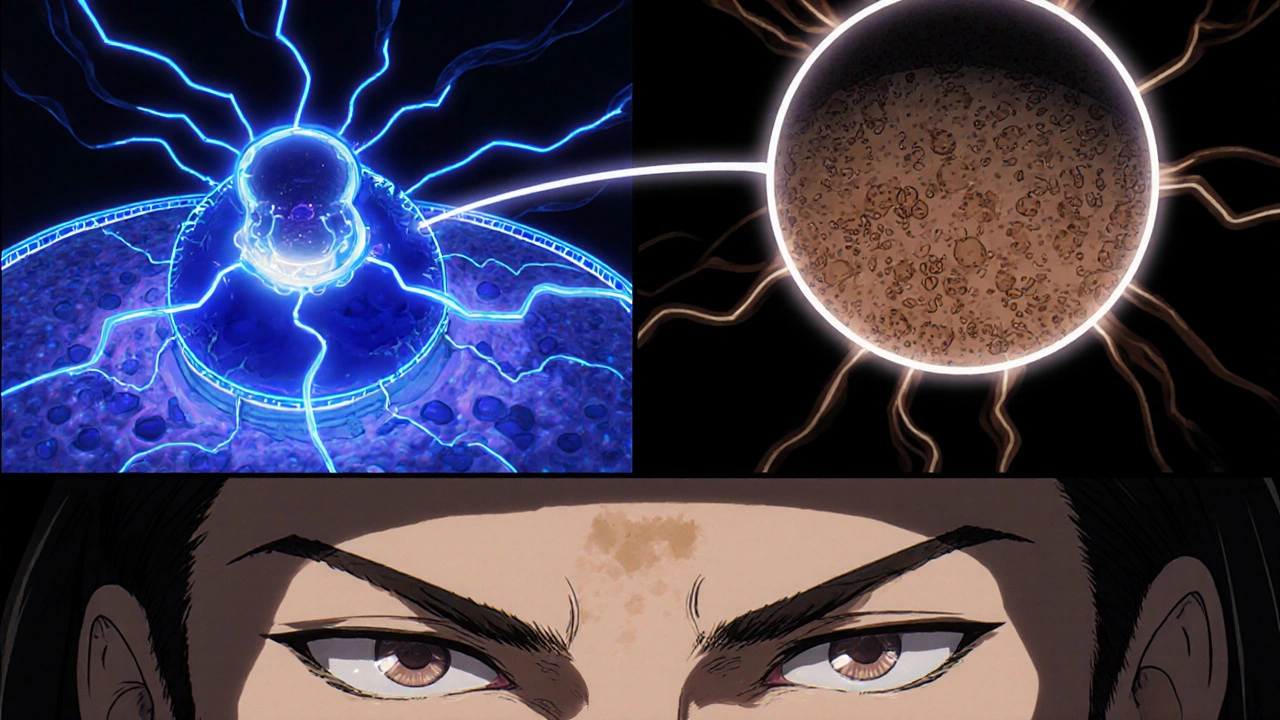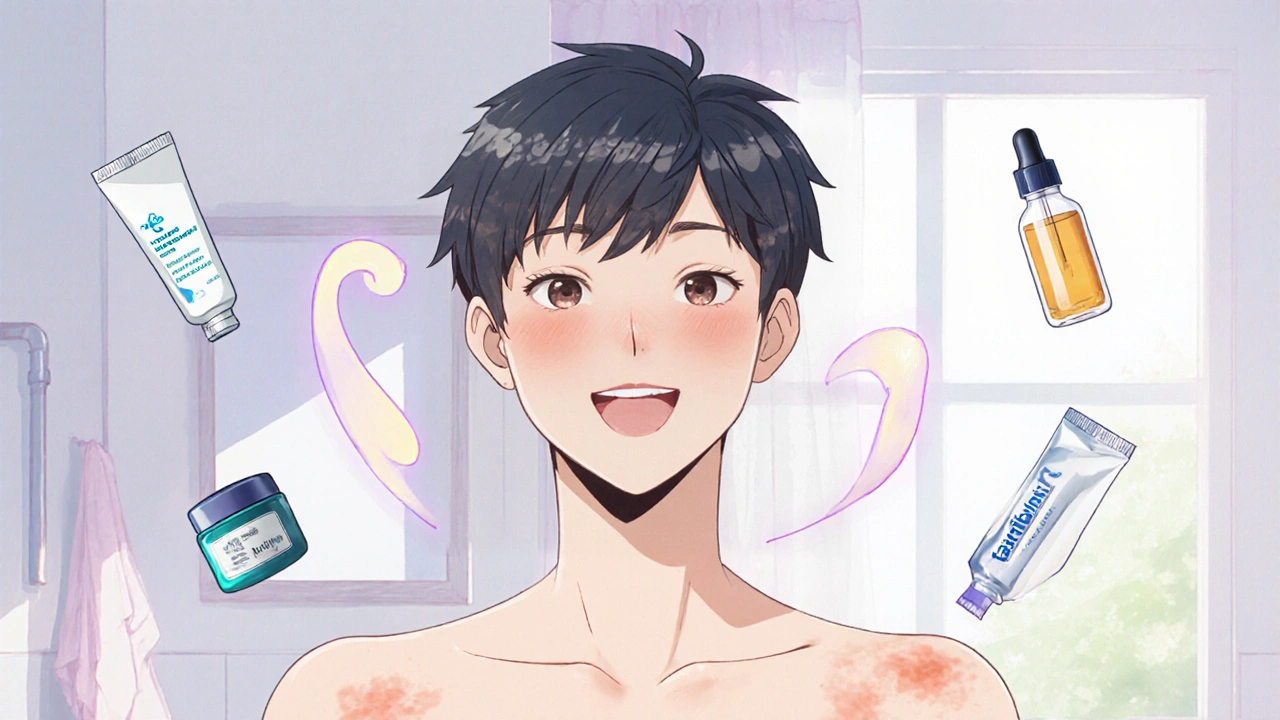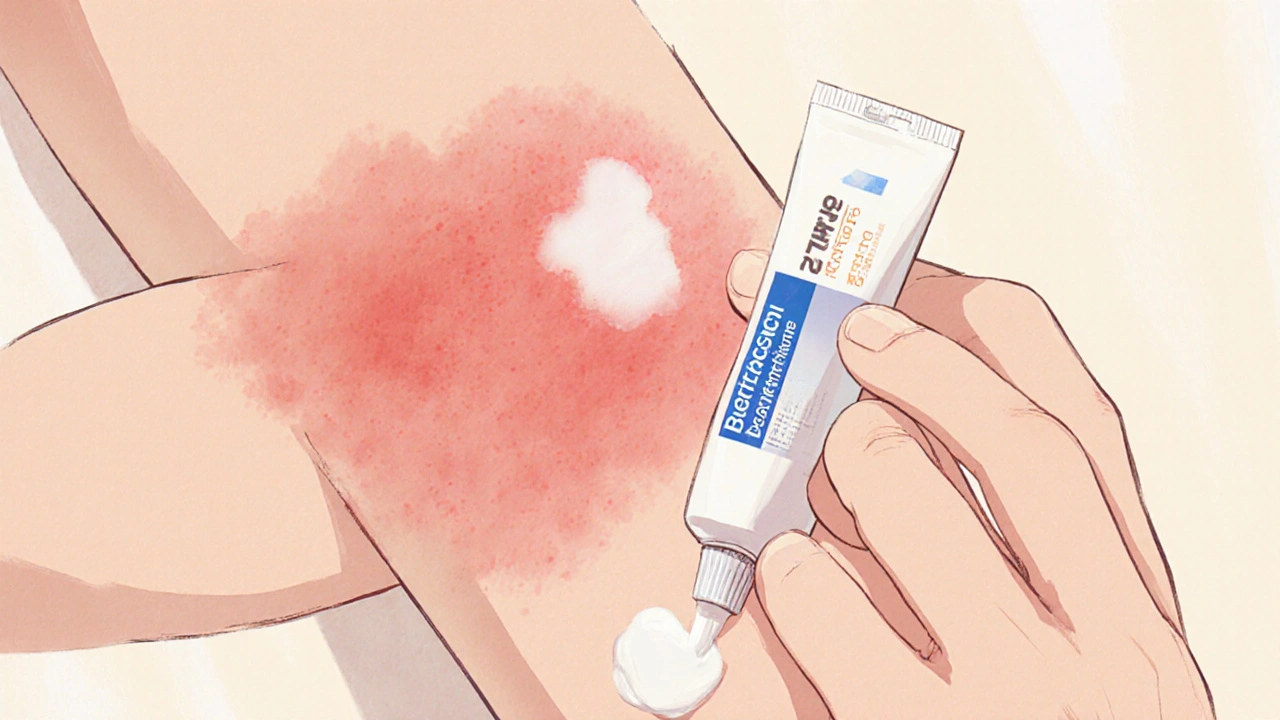Betamethasone Skin Discoloration Risk Calculator
Calculate Your Risk
Results
When you reach for a cream to calm an itchy rash, you probably aren’t thinking about how it might change the color of your skin. Yet a common complaint among users of Betamethasone is the appearance of lighter or darker patches where the medication was applied. This guide breaks down why that happens, who’s most at risk, and what you can do if discoloration shows up.
Key Takeaways
- Betamethasone is a potent topical corticosteroid that can cause both hypopigmentation and hyperpigmentation.
- Discoloration usually stems from the drug’s impact on melanin production and inflammation.
- Long‑term use, high‑strength formulations, and application on thin skin increase the risk.
- Switching to a lower‑potency steroid, using intermittent dosing, or adding a moisturizer can reduce the chance of color changes.
- If patches appear, most resolve with time, but targeted treatments speed recovery.
What Is Betamethasone?
Betamethasone is a synthetic glucocorticoid used in dermatology for its anti‑inflammatory and immunosuppressive properties. It belongs to the class of topical corticosteroids, which mimic the body’s natural cortisol hormone to calm redness, itching, and swelling.
Available as creams, ointments, and lotions, betamethasone comes in several strengths-commonly 0.05% for moderate potency and 0.064% for the more aggressive formulation. Health professionals prescribe it for conditions like atopic dermatitis, psoriasis, and inflammatory nail disorders.
How Betamethasone Works
The drug binds to the glucocorticoid receptor inside skin cells. This complex travels to the cell nucleus and switches off genes that produce inflammatory chemicals such as prostaglandins and cytokines. By dampening the immune response, the skin’s redness and itch fade.
Unfortunately, the same pathway also interferes with the production of melanin, the pigment that gives skin its color. When melanin synthesis drops, the treated area can look lighter (hypopigmentation). In other cases, the healing process after inflammation can trigger an excess of melanin, leading to darker spots (post‑inflammatory hyperpigmentation).
Types of Skin Discoloration Linked to Betamethasone
Steroid‑induced hypopigmentation appears as a pale patch that matches the shape of the applied cream. It is most common on areas with thin skin-like the face, eyelids, and genital region-where the drug penetrates deeply.
Post‑inflammatory hyperpigmentation (PIH) occurs after the original rash resolves. The skin’s repair mechanisms overproduce melanin in the damaged area, creating a brown or tan patch that can linger for months.
Both conditions are generally reversible, but the timeline varies. Hypopigmentation may fade within weeks after stopping the steroid, while PIH can persist longer, especially in darker skin types.

Who Is Most Likely to Experience Discoloration?
- Duration and frequency: Using betamethasone daily for more than two weeks raises the odds.
- Potency: The higher‑strength 0.064% formulation carries a greater risk than the 0.05% version.
- Application site: Thin skin (face, neck, flexural areas) absorbs more drug.
- Age: Children have more permeable skin, so even short courses can trigger color changes.
- Skin type: Darker phototypes (Fitzpatrick IV‑VI) are prone to PIH, while lighter tones may notice hypopigmentation more.
Mechanisms Behind the Color Shifts
When betamethasone binds to the glucocorticoid receptor, it down‑regulates the enzyme tyrosinase, a key player in melanin synthesis. Reduced tyrosinase activity means fewer melanin granules are produced, leading to a lighter patch.
Conversely, the anti‑inflammatory action can blunt the skin’s natural healing response. In the absence of inflammation, melanocytes may become over‑active to compensate, resulting in PIH. The balance between these two pathways determines which side effect shows up.
Practical Steps to Minimize the Risk
- Choose the lowest effective potency. For mild eczema, a low‑strength corticosteroid often works as well as betamethasone.
- Limit the treatment window. Follow a “pulse” schedule-apply for three days, skip two, then reassess.
- Apply a thin layer. Using just enough to cover the area reduces overall absorption.
- Combine with moisturizers. A barrier cream can dilute the steroid and keep the skin hydrated, which lowers irritation.
- Monitor high‑risk sites. Avoid continuous use on the face, genitals, or skin folds unless directed by a dermatologist.
What to Do If Discoloration Occurs
First, stop the betamethasone or switch to a milder steroid like hydrocortisone. Give the skin a break for at least a week while maintaining gentle cleansing and moisturising.
If hypopigmentation persists, consider these options:
- Topical calcineurin inhibitors (e.g., tacrolimus). They control inflammation without affecting melanin.
- Vitamin C serums. Antioxidant action can brighten pale patches over time.
- Phototherapy. Controlled UV exposure stimulates melanin production in the lightened area.
For stubborn PIH, dermatologists may prescribe:
- Hydroquinone or azelaic acid. These lighten excess pigment.
- Chemical peels. Glycolic or lactic peels gently remove pigmented skin layers.
- Laser therapy. Fractional lasers target melanin without damaging surrounding tissue.
Patience is key-most color changes improve within three to six months once the steroid is discontinued.

Alternatives to Betamethasone for Sensitive Areas
If you need a steroid‑free option, consider these proven alternatives:
| Medication | Potency (US classification) | Typical concentration | Risk of discoloration |
|---|---|---|---|
| Betamethasone | High | 0.05%‑0.064% | Moderate‑high |
| Clobetasol propionate | Very high | 0.05% | High |
| Hydrocortisone | Low | 1%‑2.5% | Low |
| Tacrolimus ointment | Non‑steroidal | 0.03%‑0.1% | Very low |
When the skin is thin or the patient is a child, many clinicians opt for hydrocortisone or tacrolimus to avoid the pigment side effects associated with betamethasone.
Special Populations: Children and Pregnancy
Children’s epidermis is more permeable, so systemic absorption can be higher. Pediatric guidelines suggest limiting betamethasone to short bursts (no longer than 2‑3 weeks) and using the lowest‑strength cream. If discoloration appears, early rotation to a milder steroid or a calcineurin inhibitor prevents chronic changes.
During pregnancy, the safety of high‑potency topical steroids is still debated. While systemic effects are rare, the potential for altered melanin distribution raises caution. Many obstetric dermatologists recommend hydrocortisone or moisturisers until after delivery.
Bottom Line
Betamethasone is an effective tool for stubborn skin inflammation, but its power can come with a price-unwanted skin color changes. Understanding the mechanisms, recognizing who’s at risk, and applying practical mitigation strategies lets you keep the skin calm without compromising its natural hue.
Frequently Asked Questions
Can betamethasone cause permanent skin discoloration?
Most pigment changes are reversible once the medication is stopped, but the timeline varies. In rare cases-especially with very high‑potency steroids used continuously for months-some residual hypopigmentation can linger.
How long does it take for hypopigmentation to fade?
Typically 4‑8 weeks after discontinuing the steroid, but darker skin types may need up to six months for full recovery.
Is it safe to use betamethasone on the face?
Only under close medical supervision. The facial skin is thin, so even a short course can cause hypopigmentation. Often, clinicians switch to a milder steroid or a non‑steroidal option for facial eruptions.
What over‑the‑counter products help treat post‑inflammatory hyperpigmentation?
Products with niacinamide, vitamin C, or azelaic acid can gradually lighten PIH. Consistent sunscreen use prevents new dark spots from forming.
Should I stop all steroids if I notice a color change?
First step is to taper or switch to a lower‑potency steroid. If discoloration persists despite a change, discuss alternative treatments with a dermatologist.


Christa Wilson
October 22, 2025 AT 21:04Great tip, thanks! 😊
John Connolly
November 1, 2025 AT 02:17Betamethasone’s potency makes it a double‑edged sword for dermatologic therapy.
When you apply it to thin skin, the drug penetrates deeper and can suppress tyrosinase activity, leading to hypopigmentation.
Conversely, the anti‑inflammatory effect may trigger melanocyte rebound, causing post‑inflammatory hyperpigmentation.
The literature suggests limiting application to no more than two weeks on high‑potency formulations.
Switching to a lower‑strength steroid or a calcineurin inhibitor can maintain control of the rash while sparing pigment.
Remember to pair the medication with a good moisturizer to preserve barrier function and reduce absorption spikes.
Sajeev Menon
November 10, 2025 AT 08:30I totally get where you're comimg from-its easy to forget that the skin on the face is super thin, so even a short burst of a high‑potency cream can shift thier melanin production.
One thing that helps a lot is to use just a pea‑sized dab and spread it thinly, otherwise you risk over‑absorbtion.
Also, rotating to a non‑steroidal option like tacrolimus after a week can give th skin a breather while still controlling inflammation.
Don't ignore the role of gentle moisturizers; they act like a barrier and keep the drug from diving too deep.
Lastly, keep an eye on any colour changes early-stop the treatment and switch before the patches become noticeable.
Emma Parker
November 19, 2025 AT 14:44Oh wow, thanks for the heads up! i didnt even think about the pea‑sized dab thing, lol.
i've actually seen a friend get a weird light patch on his cheek after using betamethasone for a rash, and he swore he stopped as soon as he saw it.
just a friendly reminder to always ask your doc before slapping on a strong steroid on your face.
also, maybe try a fragrance‑free moisturizer; they can be less irritating.
stay safe and keep that skin happy!
Joe Waldron
November 28, 2025 AT 20:57Betamethasone is a powerful anti‑inflammatory, but its systemic absorption can be surprisingly high, especially on compromised barriers, so clinicians should monitor both efficacy and pigmentary side effects.
Patients often underestimate the cumulative dose when applying multiple thin layers, which can inadvertently increase the risk of hypopigmentation.
Furthermore, the interplay between glucocorticoid receptors and melanocyte activity suggests that even short‑term use may alter melanin synthesis pathways.
In practice, a “pulse‑therapy” schedule-three days on, two days off-has been shown to mitigate these risks while preserving therapeutic benefit.
Finally, combining the steroid with a barrier‑enhancing moisturizer not only improves comfort but also reduces percutaneous penetration.
Wade Grindle
December 8, 2025 AT 03:10I agree with the pulse‑therapy approach; the evidence supports a lower cumulative exposure without sacrificing anti‑inflammatory control.
Additionally, educating patients about the importance of applying a thin film can dramatically cut down on unwanted pigment changes.
From a cultural perspective, patients with darker Fitzpatrick skin types should be counseled on the higher propensity for post‑inflammatory hyperpigmentation and offered early photoprotective measures.
Incorporating sunscreen into the regimen is a simple yet effective adjunct.
Sarah Riley
December 17, 2025 AT 09:24The melanogenic pathway modulation by glucocorticoid receptor agonism induces pigmentary dysregulation.